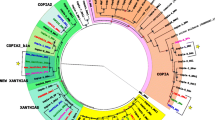Abstract
The occurrence, number of insertion sites and antisense RNA expression of micropia transposable element were studied in 26 species that belong to three subgroups (mercatorum, mulleri and hydei) of repleta group of Drosophila. Under high specific PCR, micropia sequences were detected in 11 species, but under less stringent condition, this retrotransposon was detected in all species. The widespread distribution of micropia suggests that this element was already present at the common ancestor of the repleta group of Drosophila. Southern blot analysis showed a variation from 0 to 17 different insertion sites and the occurrence of male-specific sequences. We found that the expression of the 1.0 kb micropia antisense RNA is variable among the species and tissues (soma and testis), which suggests that more than one mechanism regulates transposition in these species. Variation of amplification by PCR and of antisense RNA expression, as well as divergence of nucleotide sequences among the species allow us to suggest that at least two subfamilies of micropia transposable element are harbored by the genome of this species group.
Similar content being viewed by others
References
Almeida, L.M., J.P. Castro & C.M.A. Carareto, 2001. Micropia transposable element presence in Drosophila saltans group. Dros. Inf. Serv. 84: 114–117.
Capy, P., C. Bazin, D. Higuet & T. Langin, 1998. Classification of transposable elements, pp. 37–52 in Dynamics and Evolution of Transposable Elements, 1st edn. Landes Bioscience, France.
Chakrabarti, R. & C.E. Schutt, 2001. The enhancement of PCR amplification by low molecular-weight sulfones. Gene 274: 293–298.
Durando, C., R. Baker, W. Etges, B. Heed, M. Wasserman & R. De Salle, 2000. Phylogenetic analysis of the repleta species group of the genus Drosophila using multiple sources of characters. Mol. Phylogenet. Evol. 2: 296–307.
Finnegan, D., 1989. Eukaryotic transposable elements and genome evolution. Trends Genet. 5: 103–107.
Huijser, P., C. Kirchhoff, D.-H. Lankenau & W. Hennig, 1988. Retrotransposon-like sequences are expressed in Y chromosomal lampbrush loops of Drosophila hydei. J. Mol. Biol. 203: 689–697.
Jowett, T., 1986. Preparation of nucleic acids, pp. 275–286 in Roberts D.B. (ed), Drosophila: A Practical Approach, edited by D.B. Roberts. IRL Press, Oxford.
Kaplan, N.L., T. Darden & C. Langley, 1985. Evolution and extinction of transposable elements in Mendelian populations. Genetics 109: 459–480.
Lankenau, D.-H., 1993. The retrotransposon family micropia in Drosophila species, pp. 232–241 in J. McDonald(ed.), Transposable Elements and Evolution. Kluwer Publishers, Amsterdam.
Lankenau, D.-H., P. Huijer & W. Hennig, 1989. Characterization of the long terminal repeats of micropia elements dissected from the Y chromosomal lampbrush loops 'Threads' of Drosophila hydei. J. Mol. Biol. 209: 493–497.
Lankenau, S., G.V. Corces & D.-H. Lankenau, 1994. The Drosophila micropia retrotransposon encodes a testis-specific anti-sense RNA complementary to reverse transcriptase. Mol. Cell Biol. 14: 1764–1775.
Silva, J.C. & M.G. Kidwell, 2000. Horizontal transfer and selection in the evolution of P elements. Mol. Biol. Evol. 17(10): 1542–1557.
Swofford, D., 1997. PAUP: Phylogenetic analysis using parsimony. Version 4.0b10. Smithsonian Institution, Washington, D.C.
Tatarenkov, A. & J.F. Ayala, 2001. Phylogenetic relationships among species groups of virlis-repleta Radiation of Drosophila. Mol. Phylogenet. Evol. 21: 327–331.
Vanheé-Brossollet, C. & C. Vaquero, 1998. Do natural antisense transcripts make sense in eukaryotes? Gene 211: 1–9.
Thompson, J.D., D.G. Higgins & T.J. Gibson, 1994. CLUSTAL W: improving the sensitivity of progressive multiple sequence alignment through sequence weighting, position-specific gap penalties and weight matrix choice. Nucleic Acids Res. 22: 4673–4680.
Author information
Authors and Affiliations
Rights and permissions
About this article
Cite this article
de Almeida, L.M., Carareto, C.M. Identification of Two Subfamilies of micropia Transposable Element in Species of the repleta Group of Drosophila . Genetica 121, 155–164 (2004). https://doi.org/10.1023/B:GENE.0000040386.70086.71
Issue Date:
DOI: https://doi.org/10.1023/B:GENE.0000040386.70086.71




